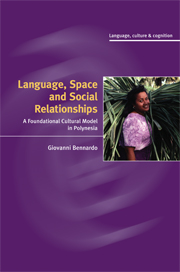Book contents
- Frontmatter
- Contents
- List of figures
- List of tables
- Preface
- Acknowledgments
- List of abbreviations
- 1 A foundational cultural model in Tongan language, culture, and social relationships
- 2 The Kingdom of Tonga: country, people, and language
- Part I Space in Tongan language, culture, and cognition
- Part II Radiality
- Part III Radiality in social relationships
- 9 Radiality and speech about social relationships
- 10 Radiality and mental representations of social relationships
- 11 Radiality in social networks
- 12 A radial mind
- References
- Author Index
- Subject Index
11 - Radiality in social networks
from Part III - Radiality in social relationships
Published online by Cambridge University Press: 19 August 2009
- Frontmatter
- Contents
- List of figures
- List of tables
- Preface
- Acknowledgments
- List of abbreviations
- 1 A foundational cultural model in Tongan language, culture, and social relationships
- 2 The Kingdom of Tonga: country, people, and language
- Part I Space in Tongan language, culture, and cognition
- Part II Radiality
- Part III Radiality in social relationships
- 9 Radiality and speech about social relationships
- 10 Radiality and mental representations of social relationships
- 11 Radiality in social networks
- 12 A radial mind
- References
- Author Index
- Subject Index
Summary
Introduction: why social networks?
When one investigates the mental representation of spatial relationships, a very common methodology includes the use of maps. Subjects are asked to draw maps, to transfer information from or to maps, to talk about maps, and so on (see Gould and White, 1974; Downs and Stea, 1977; Tversky, 1981, 1993, 1996; Golledge, 1999; Bennardo, 2002a). The discrepancies and/or distortions of the geographical world produced in the maps drawn, or the places reached, or in the speech elicited are used to hypothesize specific mental representations of spatial relationships in those individuals. Subjects' performance is matched with geographical reality to obtain information-rich data about mental representations of space.
A map, however, is only one of the many ways in which we represent reality, a reduction of the almost infinite details that characterize the world around us. Nonetheless, working with maps gives us a good insight into the way spatial relationships are represented in the mind and the way in which one works with these mental representations to navigate in the world. In short, we use maps to understand how we represent the world and how we further process these representations in reasoning about and acting in the world.
When it comes to social relationships, researchers are typically amazed at their intricacies and complexity.
- Type
- Chapter
- Information
- Language, Space, and Social RelationshipsA Foundational Cultural Model in Polynesia, pp. 309 - 338Publisher: Cambridge University PressPrint publication year: 2009



